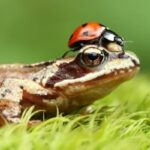We explain what ovoviviparous animals are, their characteristics and examples. Furthermore, oviparous and viviparous animals.

What are ovoviviparous animals?
In biology, ovoviviparous animals are called those whose reproduction mechanism consists of the formation of eggs inside the female's belly where the embryo matures until it is close to hatching, and only then are they deposited or expelled from the parent's body.
Thus, ovoviviparity is, in some way, halfway between the mode of reproduction of oviparous and viviparous, that is, It is something intermediate between ordinary egg laying and childbirth. This is because animals of this type develop inside an egg, but said egg does not leave the mother's body until a few moments before hatching.
This type of reproductive mechanism is common among invertebrate species, but also among some species of reptiles and fish. But in all cases internal fertilization occurs, that is, during copulation the male introduces his genetic material into the female's body.
Depending on the relationship established between the mother's body and the egg where the embryo develops, we can classify ovoviviparous animals into:
- Those whose embryos are fed throughout the gestation process from the yolk of the egg, without requiring any type of maternal food.
- Those whose embryos exhaust the energy content of the egg and require the supply of nutrients from the maternal body, in the form of unfertilized eggs or uterine secretions.
Characteristics of ovoviviparous animals
Ovoviviparous animals are characterized as follows:
- Its reproductive mechanism involves internal fertilization and subsequent retention of the egg in a specialized duct within your reproductive tract. This is equivalent to saying that, instead of laying their eggs and then hatching them, as birds do, these animals hatch them inside their body and release them when the baby is about to hatch.
- This process is very similar in appearance to that of the viviparous, which give birth to the young alive and formed, but unlike them, the ovoviviparous do not form a placenta, since the nutrition of the young generally depends on the contents of the egg. I mean, There is no placenta and umbilical cord connecting the mother to the offspring.
- The eggs of ovoviviparous birds are much larger and have a thinner shell than those of oviviparous birds which allows in some species that, upon being expelled from the mother's body, the egg cracks and the offspring goes free into the environment.
Examples of ovoviviparous animals

Some examples of ovoviviparous animals are the following:
- Different species of sharks as is the case of Squalus acanthias (known as galludo, dogfish or tollo de cacho), reproduce ovoviviparously: the fertilized eggs hatch early inside the female's oviduct, and the young feed on their contents and the secretions of the mother's body until they are expelled complete and formed.
- Certain vipers and snakes like the asp (Vipera aspis), typical of Europe, they reproduce in an ovoviviparous manner, expelling the live young along with the remains of the egg hatched from the mother's body, when they are already mature.
- Most species of marine rays (rajiformes or rayiformes) expel the young from the mother's body once the egg is about to hatch, so that they give the appearance of being “giving birth”. In other species, the eggs are expelled early and adhere to plants and rocks with a sticky substance.
- The amphibian species Limnonectes larvaepartus a type of frog endemic to Indonesia, is one of the few examples of ovoviviparous amphibians, whose fertilization is internal and, once hatched from the egg, the tadpoles are expelled directly into the water by the mother's body.
Oviparous animals

Oviparous animals are those that they reproduce by laying eggs. They are the most numerous animals on the planet, and can reproduce through internal fertilization (the male directly fertilizes the female), or external (male and female release their gametes and fertilization occurs in the environment).
In both cases, once fertilization has occurred and the egg is placed, the parents have nothing to do with the nutrition of the embryo, which depends on the contents of the egg itself.
Most insects, fish, amphibians, birds and various invertebrates belong to this classification.
viviparous animals
Viviparous animals are those that They gestate their young within a placenta, inside the mother's body where they are protected and fed until the moment of their birth and release into the outside world. The maternal body provides them with the necessary nutrients for their development, so they require internal fertilization and eggs are not produced at any time.
Mammals in general are viviparous, including humans and higher primates.
References
- “Ovoviviparity” on Wikipedia.
- “Unit 5. Emergence of a new life” in the Learning Guide of the Ministry of Education of El Salvador.
- “Oviparous, viviparous and ovoviviparous animals” in ABC (Paraguay).
- “Ovoviviparity” in The Encyclopaedia Britannica.





